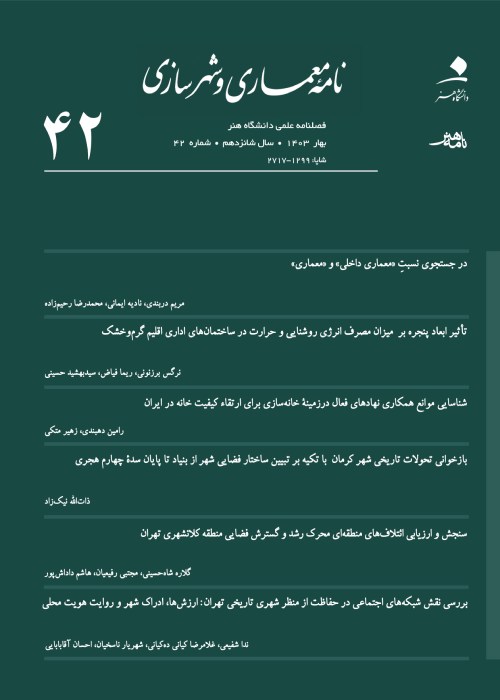From Time to Eternity (Sarmād) in Human & Architecture
Author(s):
Abstract:
The recognition of time depends more on high hierarchy of universal entity and “that universe” and less on logical and scientific views of “this universe” and its manifestation in human and architecture is the object of this essay. After looking for time in existent Iranian - mysticism theories, we got to negation of conventional absoluteness, observed modification, homogeneous, unilateral and lack of meaning; “time”, in its high rank of eternity (sarmād), in which human with his/her conception has tried to manifest it in different cultural manifestations. In this paper, for reflecting the theoretical foundations to understand the nature and different rankings of time, the issue has been considered from the order of its conventional and measured rank, to what is called as “universe” (dāhr) and “eternity” (sarmād) in Iranian Gnosticism. In order to understand the standard meaning of Time, variable aspects of creation and appearance system (i.e. “To Be” in the world) is needed to be explored; and to understand the infinite (sarmād) time, we have to consider more about transcendent order of “existence” world. Since the purpose was not only historiography, therefore, by taking a look at time in west world, we were seeking the source and theoretical foundation of this meaning in local culture; may we can find a way to obtain a better understanding of it’s various manifestations, including in architecture and cinema. We also believe as Grabar does that in mechanism of perception of art, we also need an operation system whether consciously or unconsciously, more or less the same as computer users needs, to make the mechanism work and to make the arts become meaningful. So, the strategy of theorization of this article is based on monotheistic existence dimension and existence recognition. Time appears in a world which is owned by man, not independent of him, time which is showing “A way from Human to God” and it is far away from the related concepts and connections between time and place. Through this way and by transcendent order, we move from one point in ourselves, sometimes without any physical movement; this change happens in one “eternal moment’, which is measured about several hours or days by the mechanical tools and timers, but for the person who experiences this eternal moment, it seems stationary and full of presence. Viewing these differences in artistic manifestation can lead us to their truth. Old architectures have manifested time in both passing spaces and pausing privacies. Centre in those architectures is an impression of time stopped in such presences and has been a possibility for polarizing the surrounding area. It was faded in the continued space, synchrony of the places of the modern architecture and the sameness of today’s democracy. Time in architecture can be the same as resultant existent and be interrelated to it. This characteristic gives the opportunity to artists to create dynamic spaces with different layers and surfaces, which can appear to be without the sameness in relation to each other in order to comprehend different ranks using different perceptions.
Keywords:
Language:
Persian
Published:
Journal of Architecture and Urban Planning, Volume:2 Issue: 3, 2009
Page:
117
magiran.com/p1161716
دانلود و مطالعه متن این مقاله با یکی از روشهای زیر امکان پذیر است:
اشتراک شخصی
با عضویت و پرداخت آنلاین حق اشتراک یکساله به مبلغ 1,390,000ريال میتوانید 70 عنوان مطلب دانلود کنید!
اشتراک سازمانی
به کتابخانه دانشگاه یا محل کار خود پیشنهاد کنید تا اشتراک سازمانی این پایگاه را برای دسترسی نامحدود همه کاربران به متن مطالب تهیه نمایند!
توجه!
- حق عضویت دریافتی صرف حمایت از نشریات عضو و نگهداری، تکمیل و توسعه مگیران میشود.
- پرداخت حق اشتراک و دانلود مقالات اجازه بازنشر آن در سایر رسانههای چاپی و دیجیتال را به کاربر نمیدهد.
In order to view content subscription is required
Personal subscription
Subscribe magiran.com for 70 € euros via PayPal and download 70 articles during a year.
Organization subscription
Please contact us to subscribe your university or library for unlimited access!



